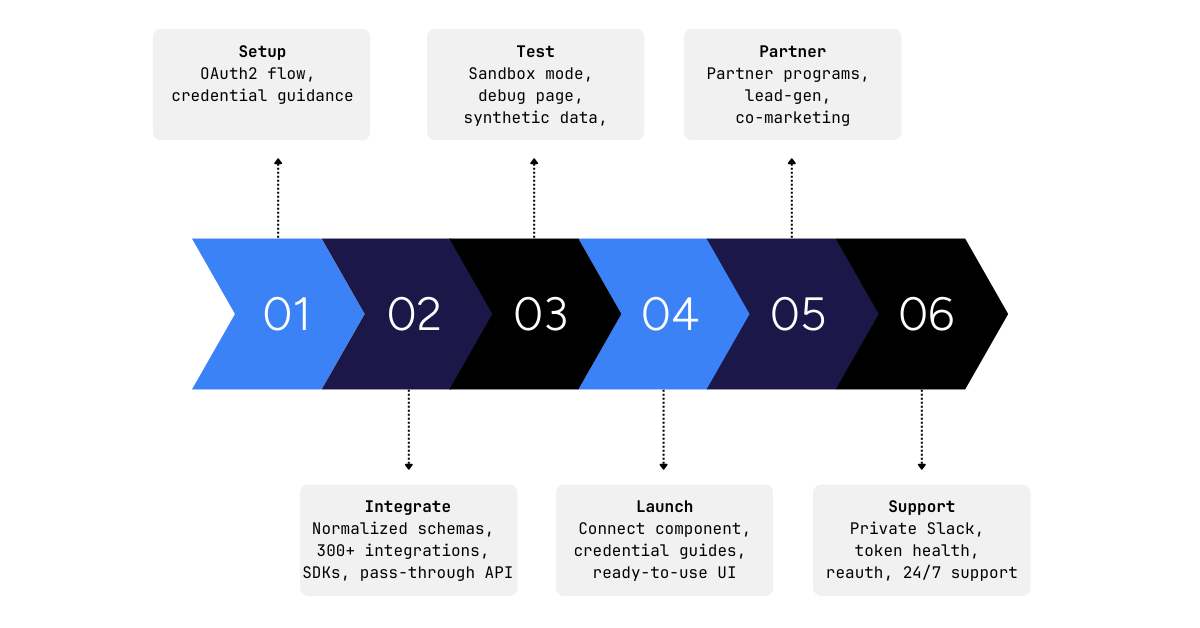How
August 21, 2025

Modern SaaS products can't compete without integrations. Whether it's syncing HRIS data, updating CRM deals, or pulling transactions from an accounting system, software teams are under pressure to deliver dozens of connectors—fast.
But shipping integrations isn't just about calling an API.
Unified.to supports you across the full integration lifecycle: from integration to launch, and beyond.
Here's what that looks like in practice.
Setup: Simplifying OAuth, Credentials, and Admin Access
Unified.to reduces friction from the start. Instead of writing separate auth flows for each vendor, you get one interface that works across 300+ apps.
- OAuth2 support (and more): Unified handles over 70 OAuth2 variations across supported integrations—including scope management, token exchange, expiration, and refresh flows. For non-OAuth systems, we support API Keys, tokens, basic auth, and other authorization models behind the scenes—so you don't have to.
- Admin-aware credentials: Unified supports both user-level and admin-level integrations (critical for HRIS and IT systems).
Developers spend less time researching scopes and configuring apps, and more time integrating.
Integrate: Real-time Unified APIs, SDKs, and Schema Normalization
Unified.to exposes a consistent, developer-friendly API layer. It's not just a wrapper, it's a unified data model.
- 300+ prebuilt integrations across 20+ categories
- Deep normalization across 1,100+ objects: Fields, enums, and relationships are standardized across systems (e.g. Contacts from Salesforce and HubSpot follow the same schema).
- 7+ auto-generated SDKs: Type-safe clients in Python, TypeScript, Go, Java, and more.
- Pass-through API support: Access non-unified endpoints with existing credentials if needed.
- Metadata APIs: Dynamically fetch available fields, enums, and object structures (helpful for CRMs and ATSs with custom fields).
The result: less conditional logic, fewer edge cases, and a consistent backend model for your product.
Test: Synthetic Data, Debugging Tools, and End-to-End Sandboxes
Unified.to offers dedicated testing environments so teams can validate before going live.
- Full sandbox environment with synthetic data allowing integration testing without live credentials.
- Built-in API Explorer: View payloads, logs, and connection health directly in the Unified app.
- 30-day unlimited trial: No usage caps during initial testing.
- Pre-configured test credentials: Use our API credentials to test your integration.
- 3rd-party sandbox links: Access guidance on where to create vendor-specific sandbox accounts (e.g., Salesforce, NetSuite)
Whether you're running QA, building staging environments, or verifying credential scopes, testing is fully supported.
Launch: Ready-to-Use UI Components and Integration Enablement
When you're ready to launch integrations to customers, Unified helps make them usable and scalable.
- Embedded Connect UI: Drop-in authorization component for your product (React, Vue, Angular, JS).
- Website integrations directory: Show off all of your new integrations on your website with just 1 line of code.
- End-user credential guides: Unified provides step-by-step instructions for customers to register apps and copy API keys (e.g. how to register a Salesforce app).
This reduces support tickets and ensures your end-users can self-serve setup confidently.
Partner: Vendor Programs and Co-Marketing
Integrations aren't just about product features—they're also a partnership opportunity. Most SaaS vendors (Workday, Salesforce, HubSpot, etc.) offer formal partner programs. Being listed as a partner can drive qualified inbound leads, strengthen customer trust, and unlock direct support channels.
Unified helps you take advantage of this by:
- Surfacing partner program information: For each supported integration, we show where to apply for that vendor's official partnership (whether it's a form, contact, or program page).
- Unified's own vendor partnerships: We maintain direct partnerships with top platforms, so we can help customers and their end-users get better technical support.
Benefits of partnering with vendors:
- Lead-gen enablement: Partner listings drive visibility on vendor marketplaces and can generate a steady flow of qualified prospects.
- Co-marketing opportunities: Joint press releases, marketplace placements, and vendor newsletters help amplify your product's reach.
- Support escalation: As an official partner, you get priority help from the vendor when troubleshooting mutual customer issues.
With Unified, you don't just ship integrations—you unlock the partnership benefits that come with them.
Support: Monitoring, Alerts, and Real Human Help
Unified's role doesn't stop at deployment. Ongoing maintenance and issue resolution are built into the platform.
- Private Slack channels for implementation and post-launch customers: Speak directly with product and support engineers.
- In-app ticketing system: Flag issues at the connection level with structured logs attached.
- Health webhooks: Receive alerts if a customer's token expires or sync fails.
- 24/7 support: Available for Grow plans and up (SLA-based).
You don't have to monitor 300+ integrations—Unified does it for you.
Beyond Integration: A Lifecycle Integration Partner
Unified.to isn't just an API layer. It's the infrastructure that supports your integrations from start to scale.
| Phase | What Unified.to Provides |
|---|---|
| Setup | OAuth2 flow, admin-aware auth, credential guidance |
| Integrate | Normalized schemas, 300+ integrations, SDKs, pass-through API |
| Test | Sandbox mode, debug page, synthetic data, mock server |
| Launch | Connect component, credential guides, website integrations UI |
| Partner | Partner program info, Unified's top-vendor partnerships, lead-gen, co-marketing, support escalation |
| Support | Private Slack, ticketing, token health, reauth, 24/7 support |
Whether you're adding your first 5 integrations or scaling to 100+, Unified handles the edge cases that slow teams down, so you can focus on shipping product.
Ready to replace glue code with something better? Start your trial or talk to our team to see how Unified supports your full integration lifecycle.
